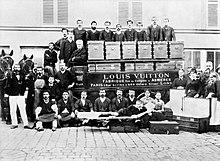| Louis Vuitton | |
|---|---|
 | |
| Born | (1821-08-04)4 August 1821 Anchay, Jura, France |
| Died | 27 February 1892(1892-02-27) (aged 70) Asnières-sur-Seine, France |
| Occupation | Malletier |
| Known for | The founder of Louis Vuitton |
| Spouse | Clemence-Emilie Parriaux |
| Children | Georges Ferréol Vuitton |
Louis Vuitton (French: [lwi vɥitɔ̃] ; 4 August 1821 – 27 February 1892) was a French fashion designer and businessman. He was the founder of the Louis Vuitton brand of leather goods now owned by LVMH. Prior to this, he had been appointed as trunk-maker to Empress Eugénie de Montijo, wife of Napoleon III.
Life and career

Vuitton was born to a family of artisans, carpenters, and farmers. At the age of 10, his mother, a hat-maker, died, and his father followed soon after. Following a difficult relationship with his adoptive stepmother, Vuitton left his home in Jura (department), in Franche-Comté in the spring of 1835, at the age of 13. Taking odd jobs along the way, Vuitton traveled approximately 292 miles (470 km) to Paris. Arriving in 1837, in the middle of the Industrial Revolution, he apprenticed under Monsieur Marechal, a successful trunk maker and packer. Within a few years, Vuitton gained a reputation amongst Paris' more fashionable class as one of the city's premier practitioners of the craft.
After the reestablishment of the French Empire under Napoleon III, Vuitton was hired as a personal trunk maker and packer for the Empress of The French. She charged him with "packing the most beautiful clothes in a quite exquisite way." This provided Vuitton with a gateway to his other elite and royal clients who provided him with work for the rest of his career.
In 1854, at age 33, Vuitton married 16-year-old Clemence-Emilie Parriaux. Soon after, he left Marechal's shop and opened his own trunk making and packing workshop in Paris. Outside of his shop hung a sign that read: "Securely packs the most fragile objects. Specializing in packing fashions." In 1858, inspired by H.J. Cave & Sons of London, Vuitton introduced his revolutionary rectangular canvas trunks at a time when the market had only rounded-top leather trunks. The demand for Vuitton's durable, lightweight designs spurred his expansion into a larger workshop in Asnières-sur-Seine. The original pattern of the shellac embedded canvas was named "Damier".
Vuitton also designed the world's first pick-proof lock. All lock patterns were safely kept at Vuitton's workrooms and registered with the owner's name in case another key was needed.
In 1871, as a result of the Franco-Prussian War, demand fell sharply, and Vuitton's workshop was in shambles. Many of his tools were stolen and his staff were gone. Vuitton rebuilt immediately, erecting a new shop at 1 Rue Scribe, next to a prestigious jockey club in the heart of Paris. In 1872, Vuitton introduced a new line, featuring beige monogrammed designs with a red stripe that would remain a signature of his brand long after he died in 1892 due to a severe and aggressive cancer in his brain (glioblastoma).

References
- "Timeline". Louis Vuitton. Archived from the original on 19 December 2008. Retrieved 3 March 2008.
- De Luna, Alexis (1995). Contemporary fashion. London: St. James Press. p. 750. ISBN 1-55862-173-3.
- "Louis Vuitton". Vogue. UK. 20 June 2012. Archived from the original on 14 August 2016. Retrieved 26 November 2013.
- "Diamond Portraits: Louis Vuitton". Ehud Laniado. Archived from the original on 8 August 2020. Retrieved 6 September 2018.